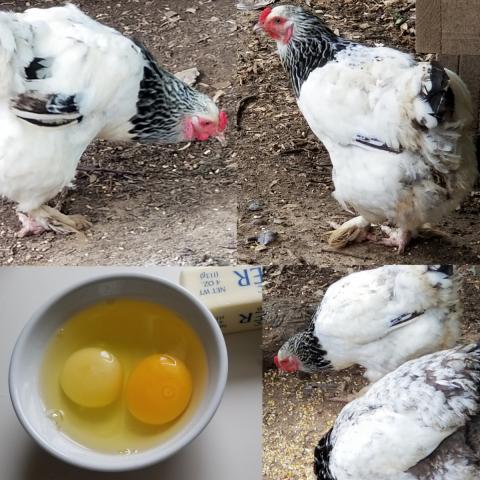
Two springs ago I incubated eggs, but only one hatched, the bird in the picture, the only one I have left now that hatched on the property. She is a storied little creature.
First, of course, I had to buy more to keep her company, so I got some rather regrettable rock cornish chicks from Tractor Supply, my first and hopefully last bird purchase from that outlet. Most were roosters, and the hen was a runt. But they kept this one company until she was grown and successfully introduced into the main flock, and then they got recycled.
Second, she has some form of albinism. You'll observe that her eyes, beak, and feet are uncharacteristically pale, and she lays pale eggs, like the one in the picture. All the other hens lay eggs like the dark yellow one. Her eggs don't taste any different, nor are they different in any other visible respect, and presumably they are nutritionally no different. All my birds get the same food: free-access layer ration, an occasional calcium supplement, and scratch grains in the morning. They also, most days, spend several hours in the afternoon foraging about the property, a fact to which I attribute the general absence of ticks and other pernicious bugs about the place.
Which brings me to the real story. They love to wander into the edge of the woods (most of our property is wooded) to forage for tender tasty wrigglies under the leaves. The woods are full of carnivores, from owls to foxes to stray hounds, but our rooster is pretty good about keeping an eye out, and we've never had trouble.
Until this spring, it happened. Wendy and I were sitting on the back deck enjoying a drink when the screaming began. I jumped up and ran towards it. The chickens were down in a little draw just the other side of our back driveway, yelling their little heads off, for a fox had found them and had the pale hen in its jaws when I crested the top of the draw. When it saw me it dropped her and ran off.
I assumed she was dead, for she didn't move and there were plenty of her feathers scattered about. I approached, contemplating how I might dispose of the corpse in some manner that didn't end up rewarding the fox, but when I got close I could hear her whimpering. I examined her carefully, and was surprised to find that there were no punctures or cuts, or even scratches, no blood at all. Her neck, however, was oddly kinked, and she remained motionless.
My first thought was to put her down, then and there, with a quick snap of the neck. It's something I've done many times in other circumstances. She was obviously traumatized and probably in considerable pain. But I couldn't be really sure of her status, and lack the training to competently assess her neck injury. So I picked her up, tucked her under my arm, and carried her back to the coop.
She lay on her breast bone in the litter, and wouldn't move. I figured by morning she'd be gone. But no, the next morning she was still there, still very much alive, still unmoving. After three days it was obvious she'd shifted enough to eat and drink, so I let her be.
I always keep older hens in the flock as "Wise Old Ones," and one of these, which can be seen in the pic at lower right, and which is either the white one's mother or (more likely) one of her aunts, took to lying with her most of the day and through the night.
Finally, after about three weeks, she made her way down the ladder from the coop into the chicken yard. But just once. Then, a week later, she came out again. Then more often.
It's been about 12 weeks or so now. She still has a little bit of an odd hump at the base of her neck, but she is otherwise fine, foraging with the flock and behaving normally. And she's started laying again. She's now the official Trauma Bird, and will be a Wise Old One in her time.
The flock remain leery of the woods, for now.
